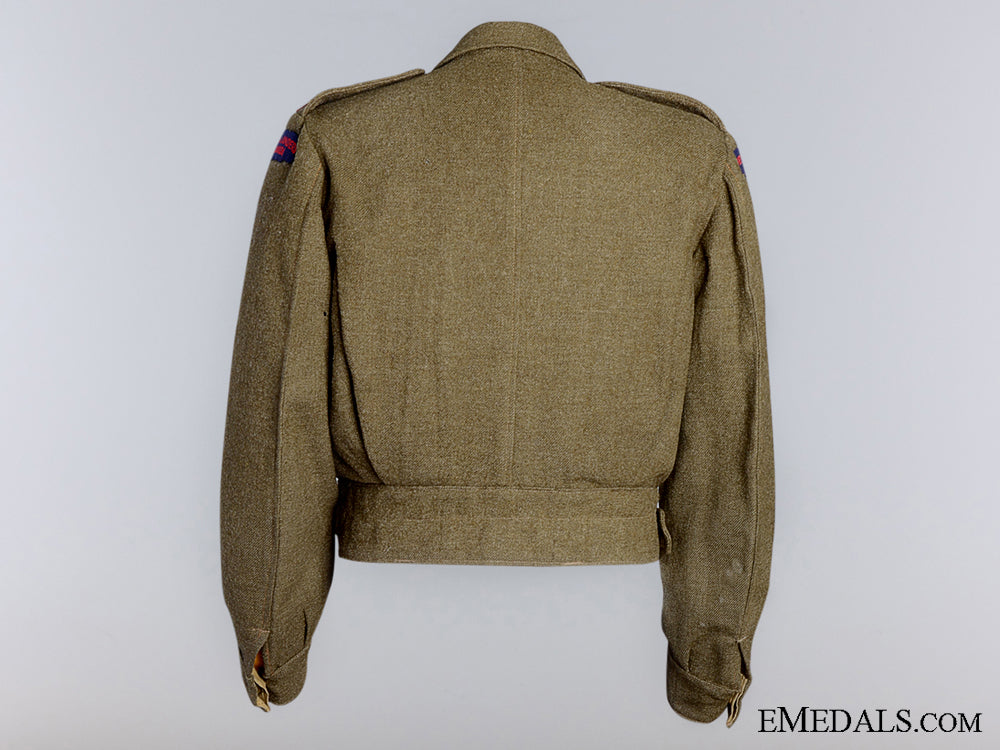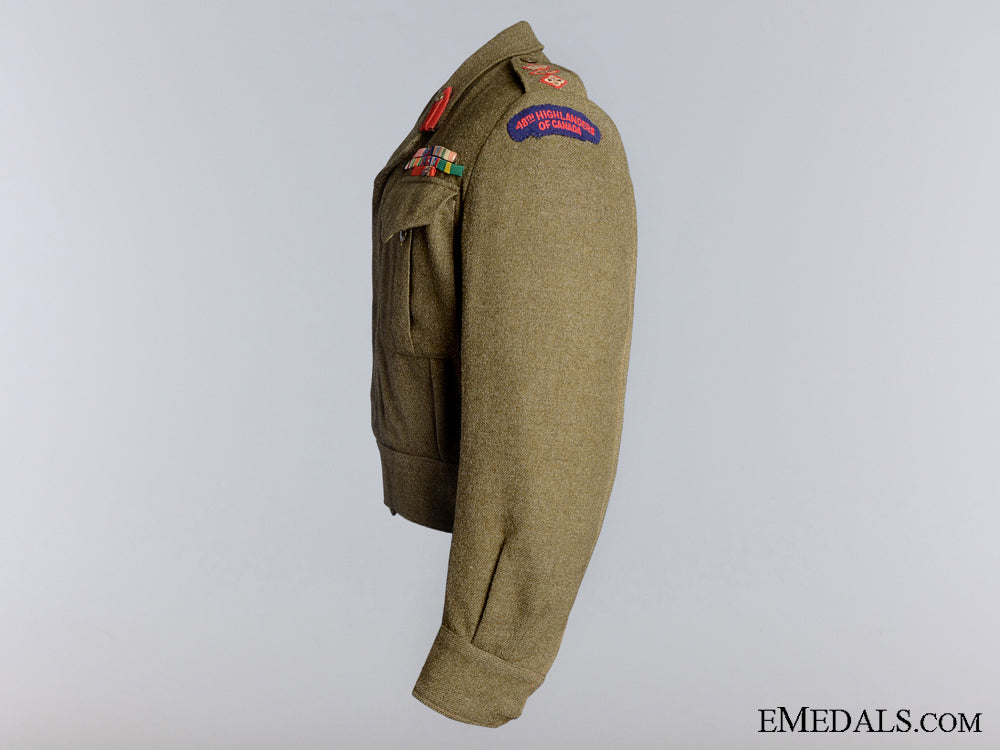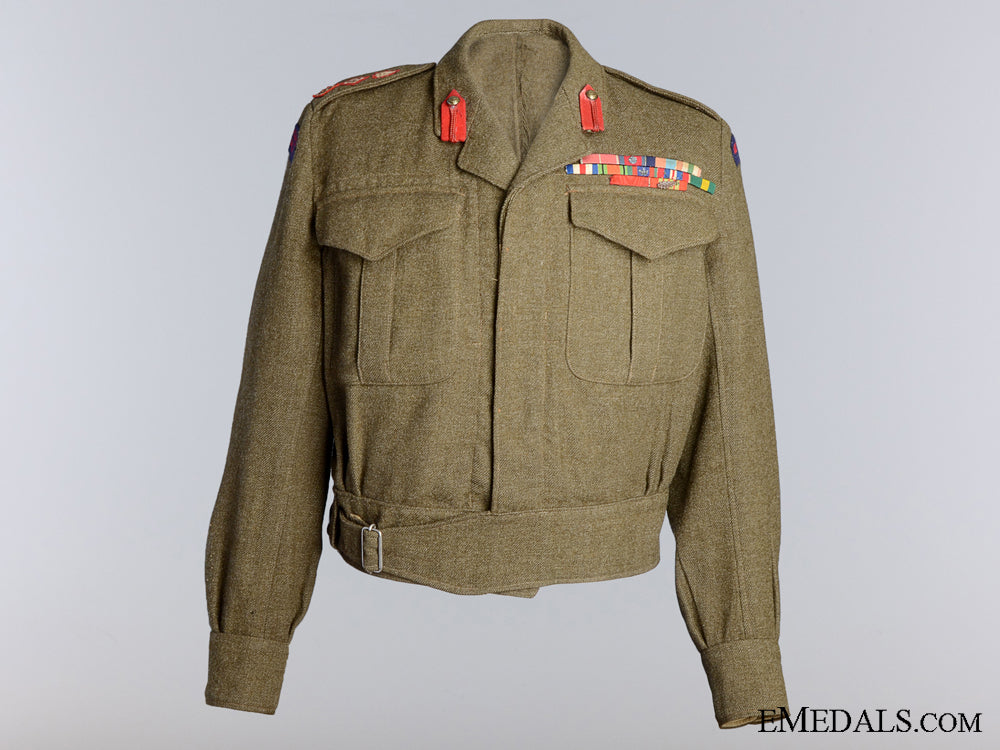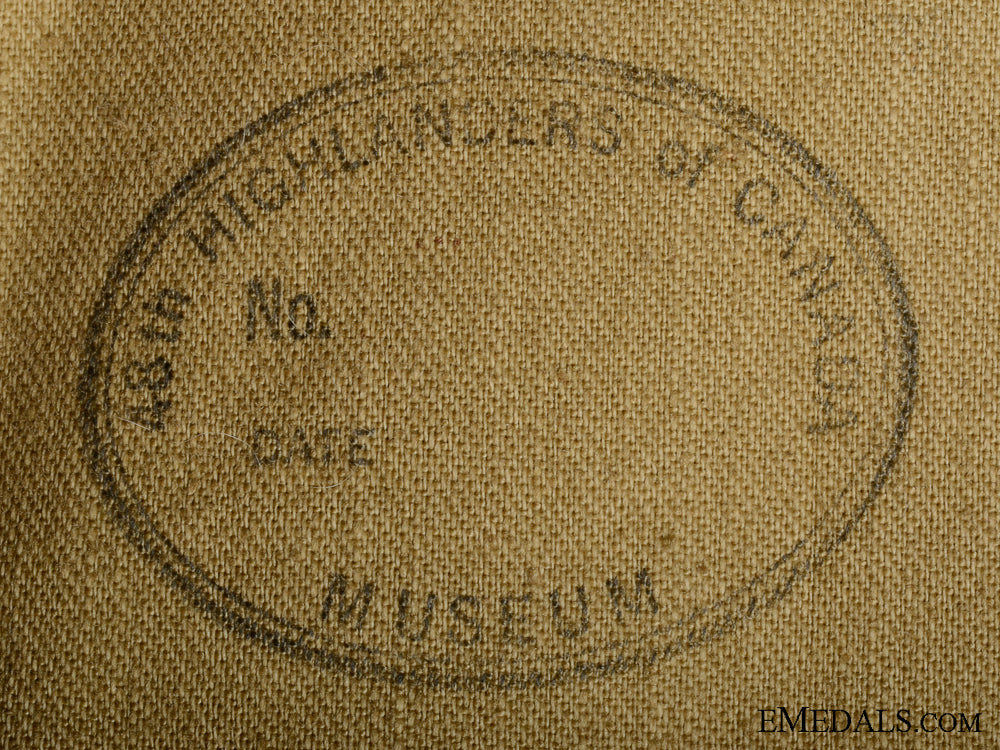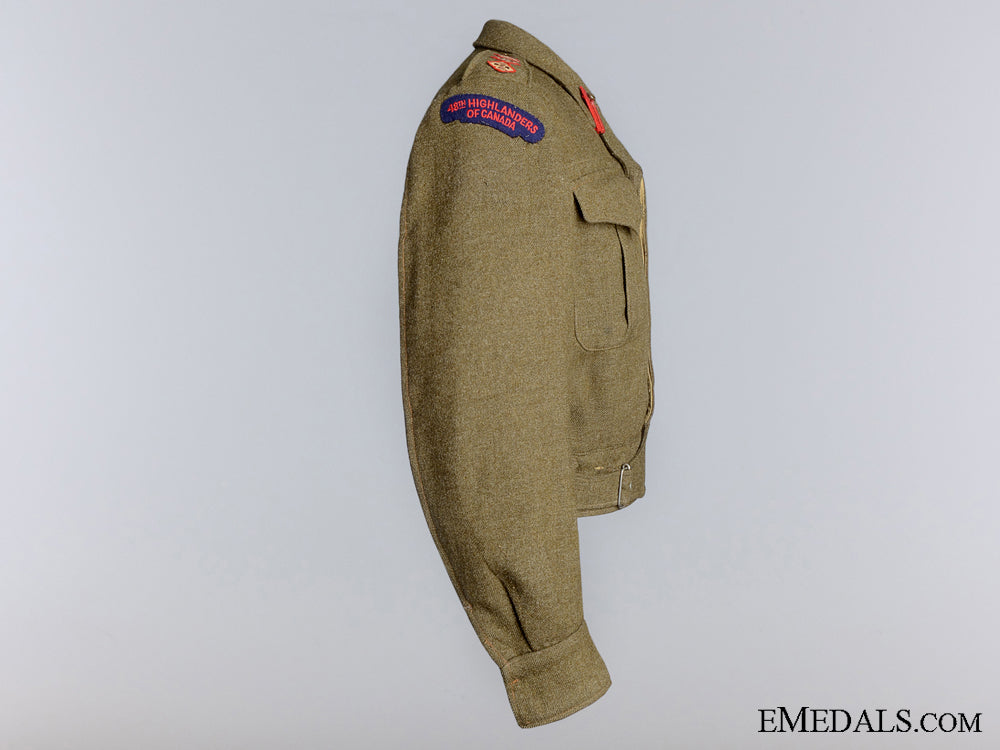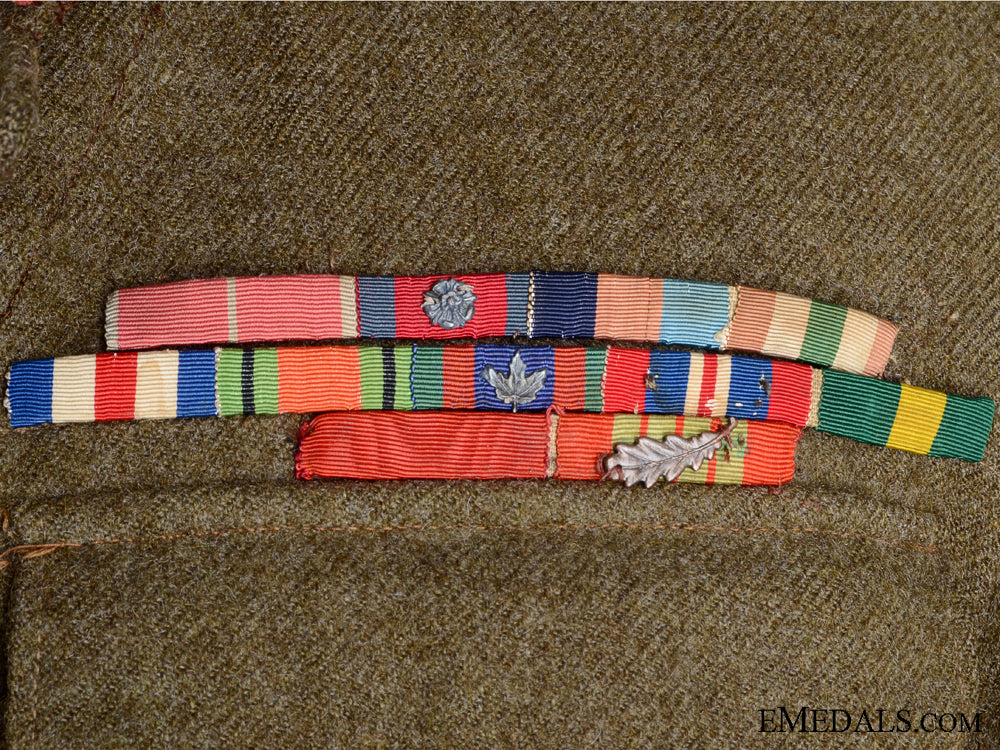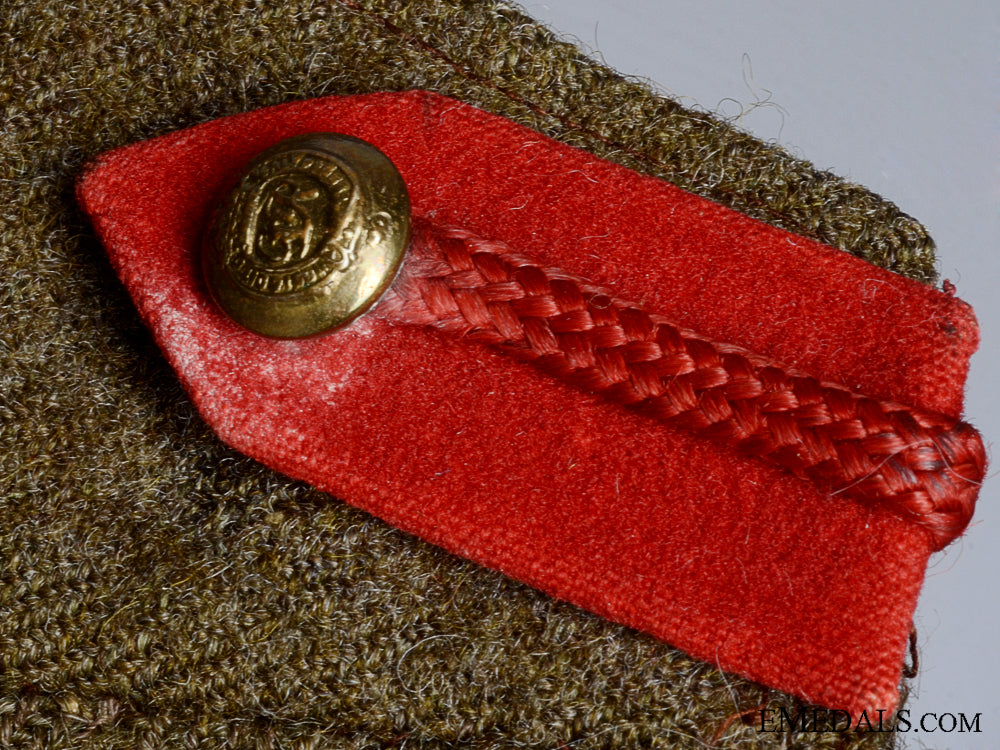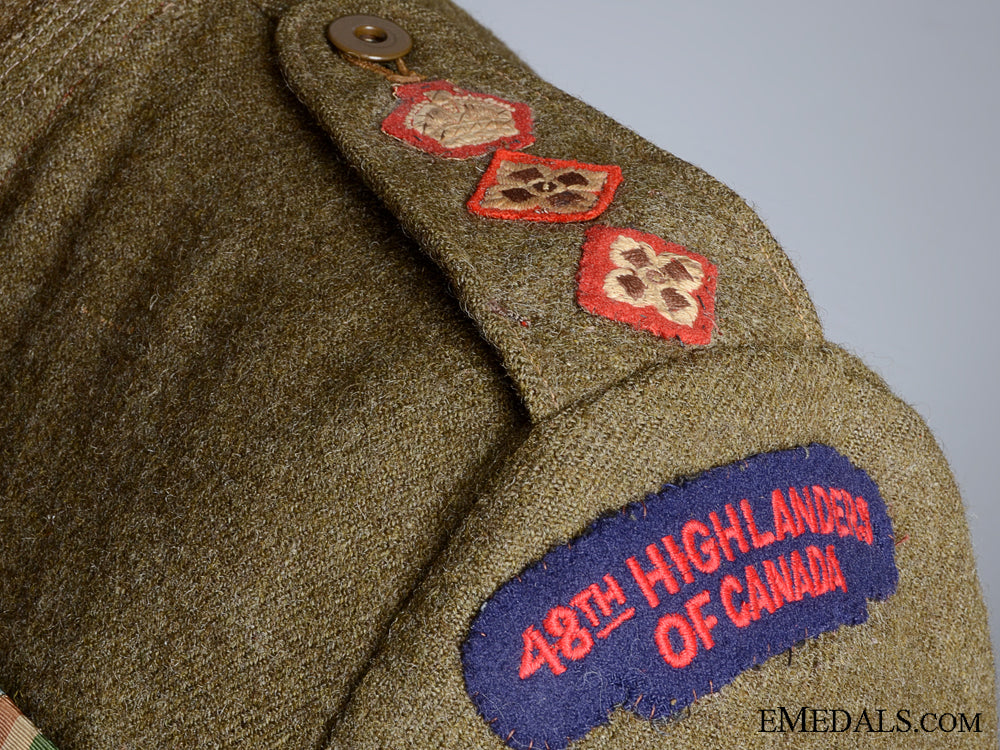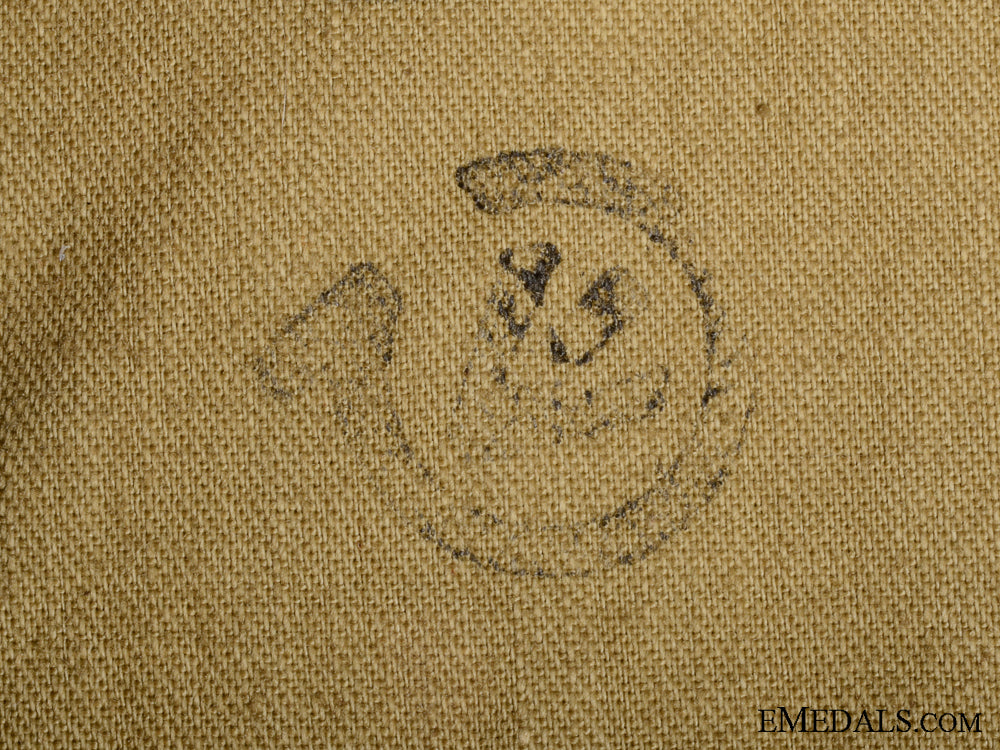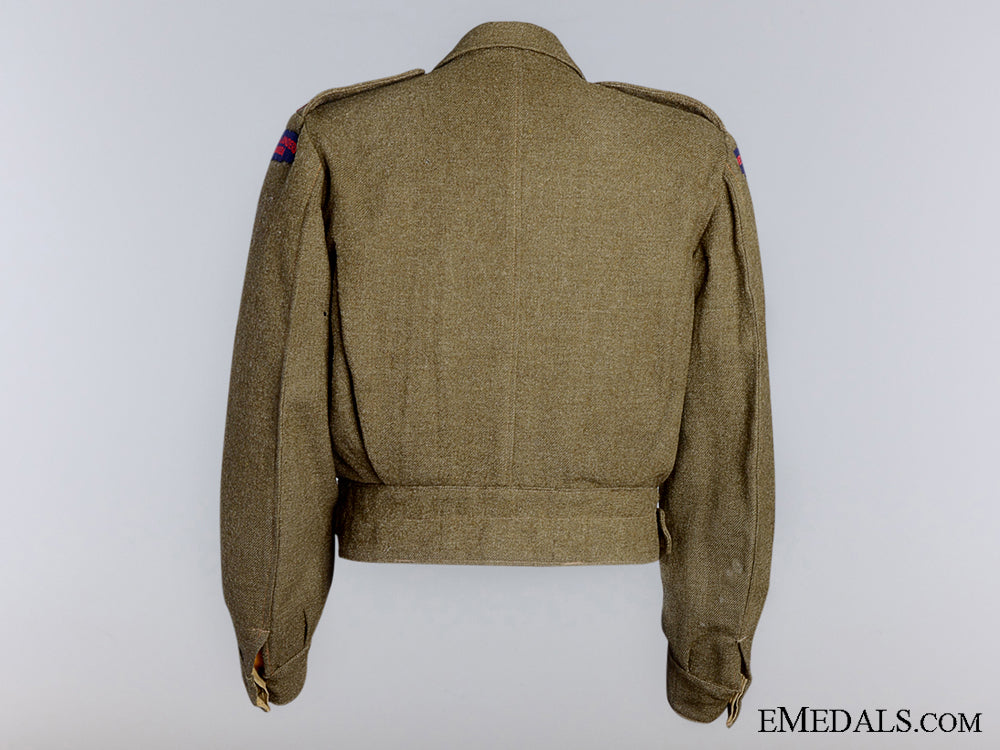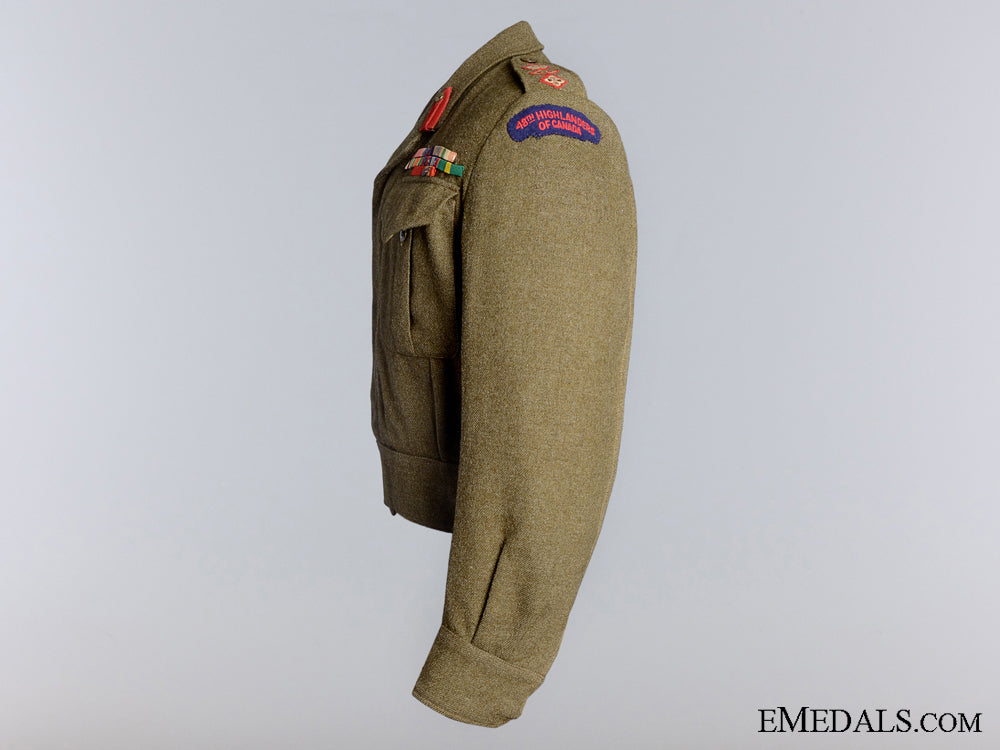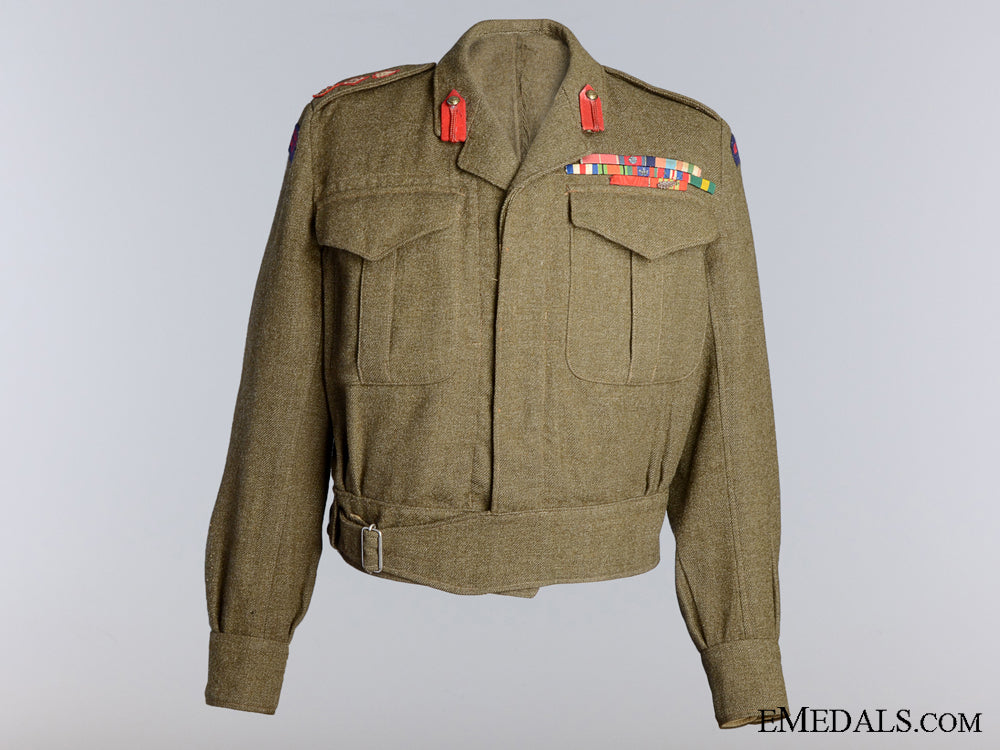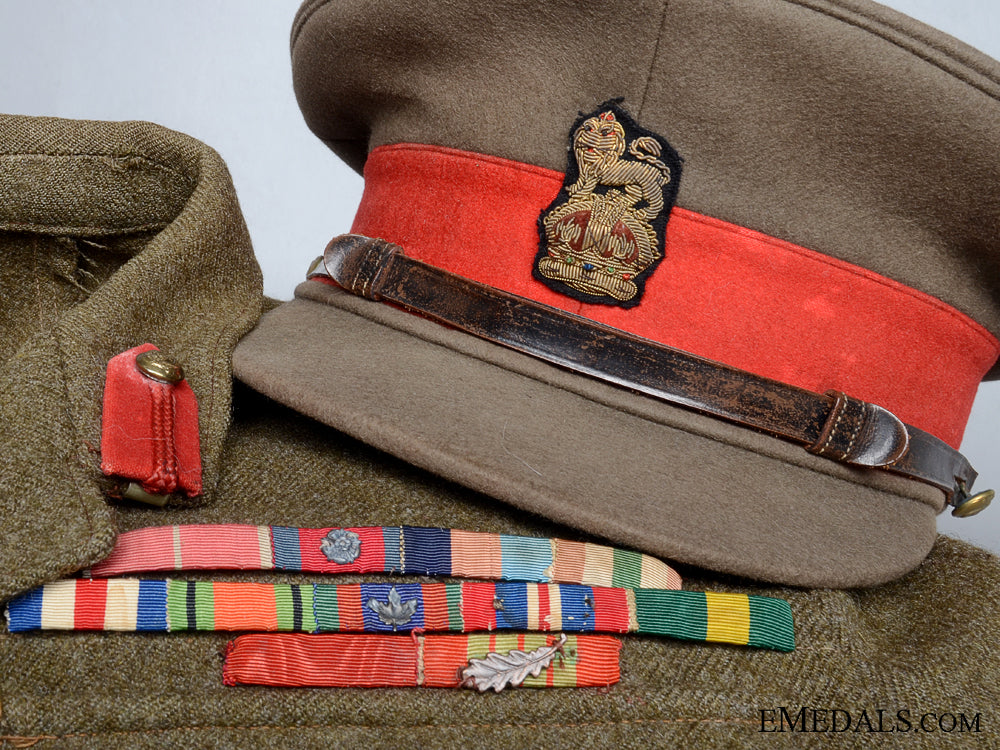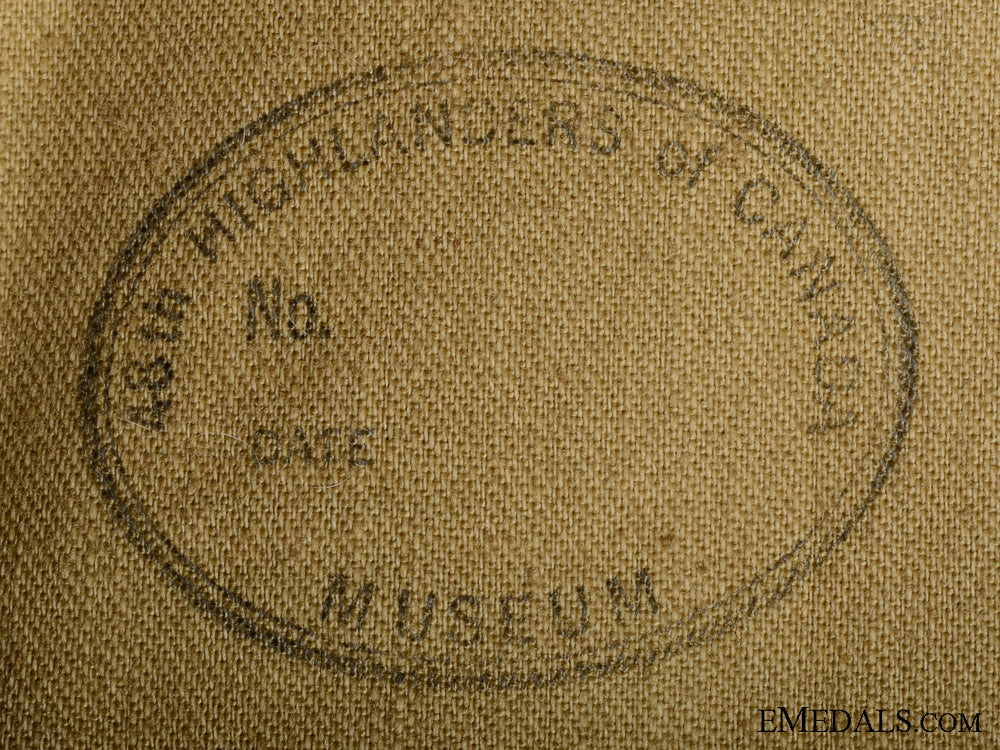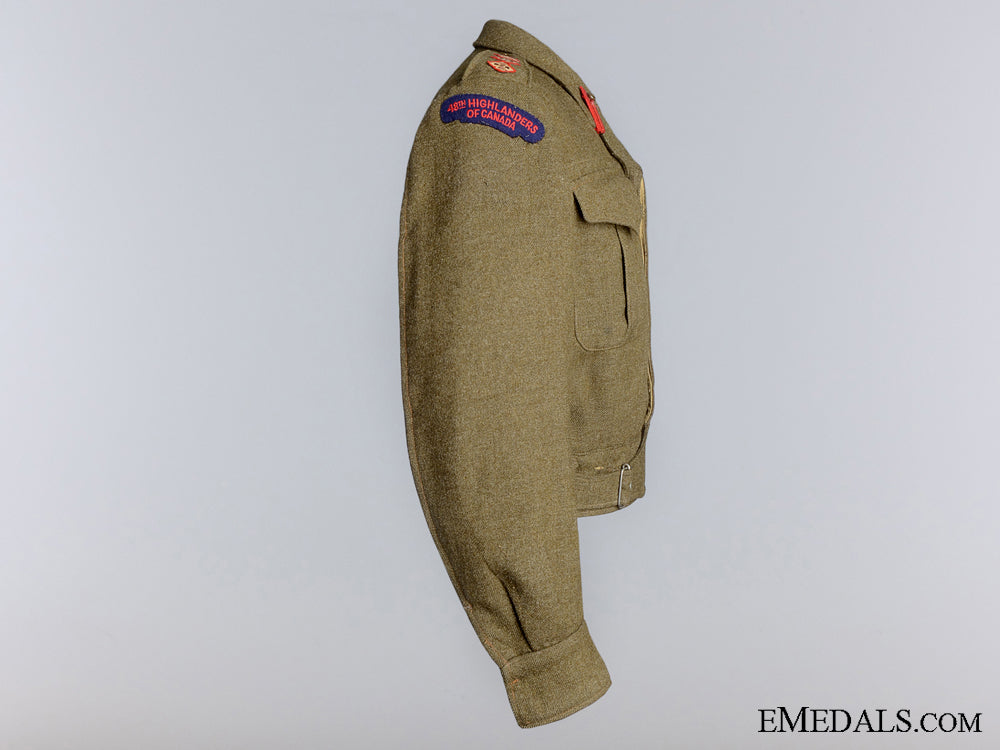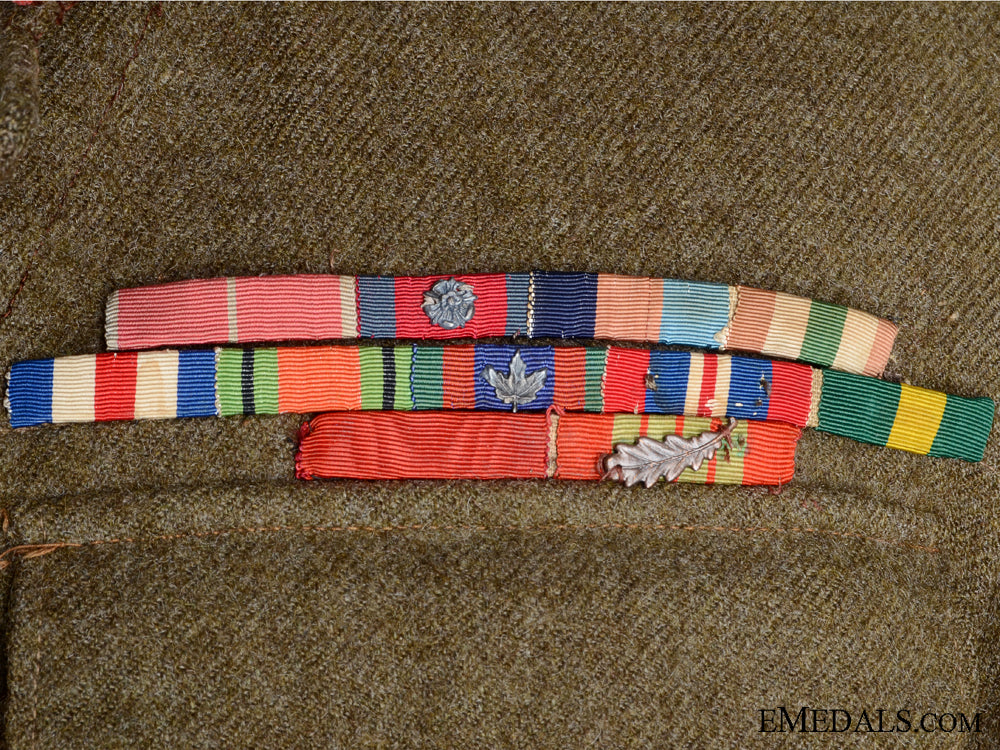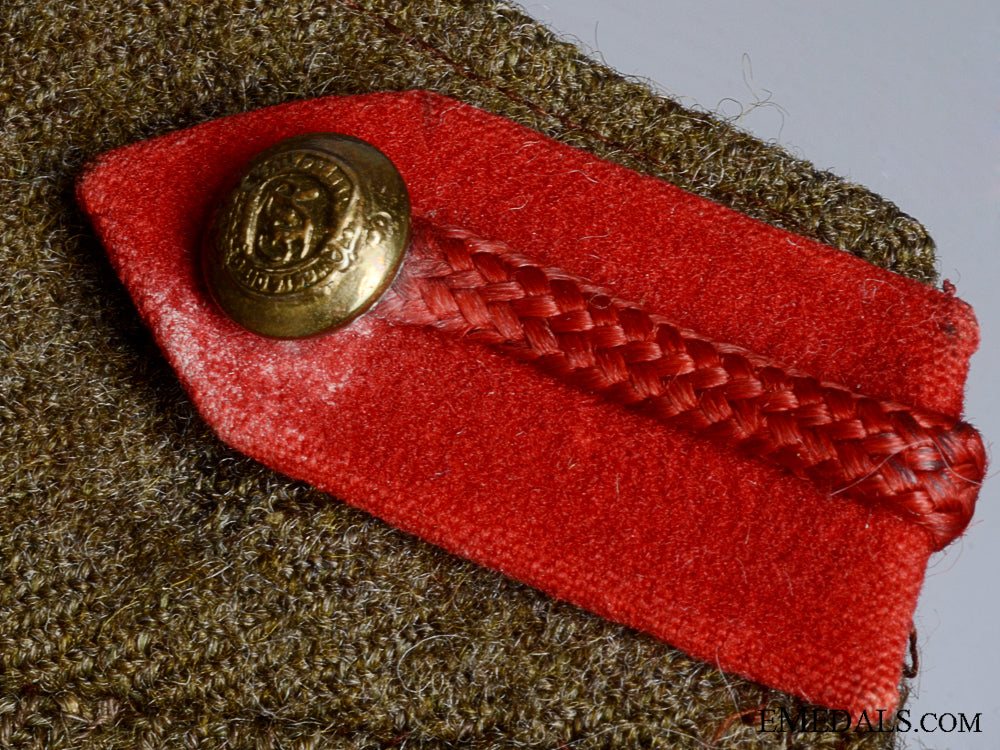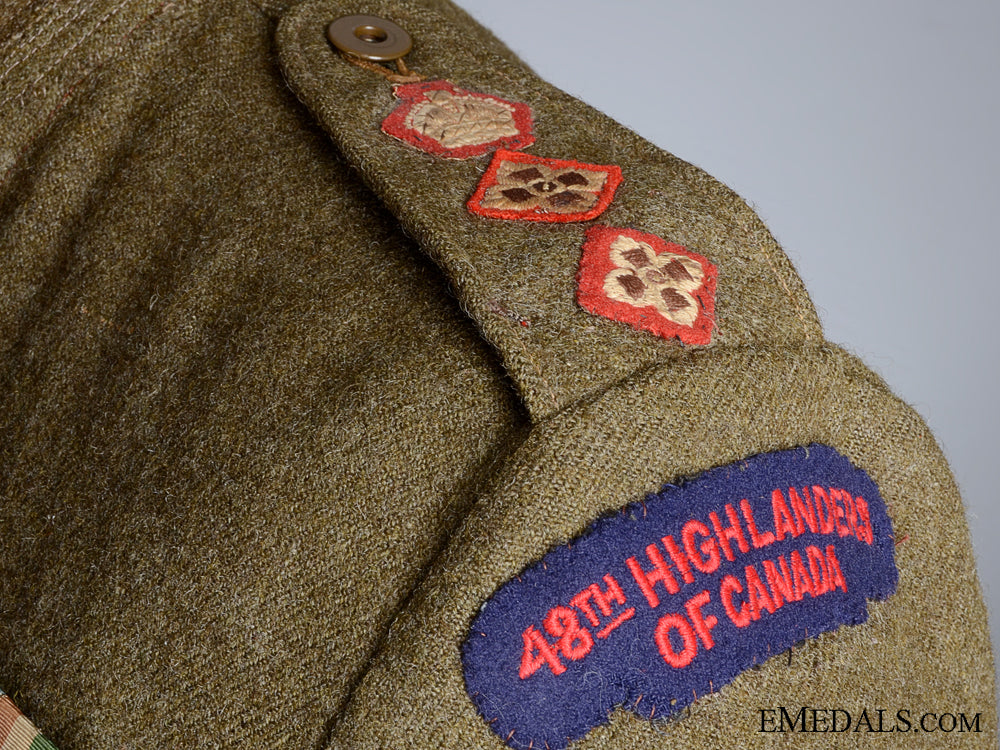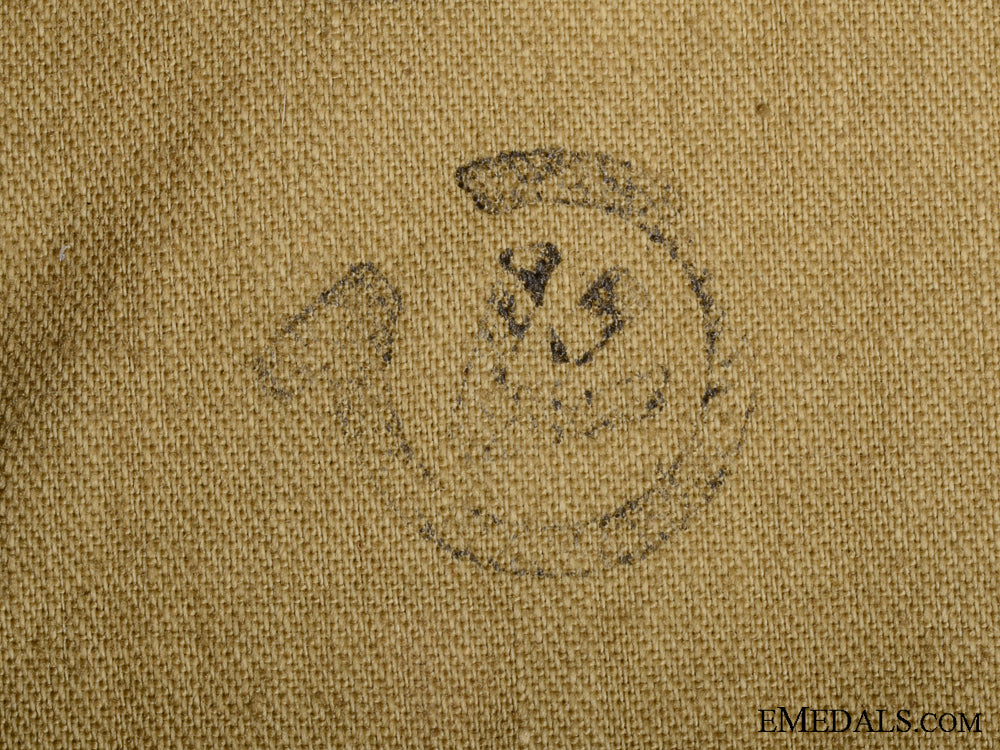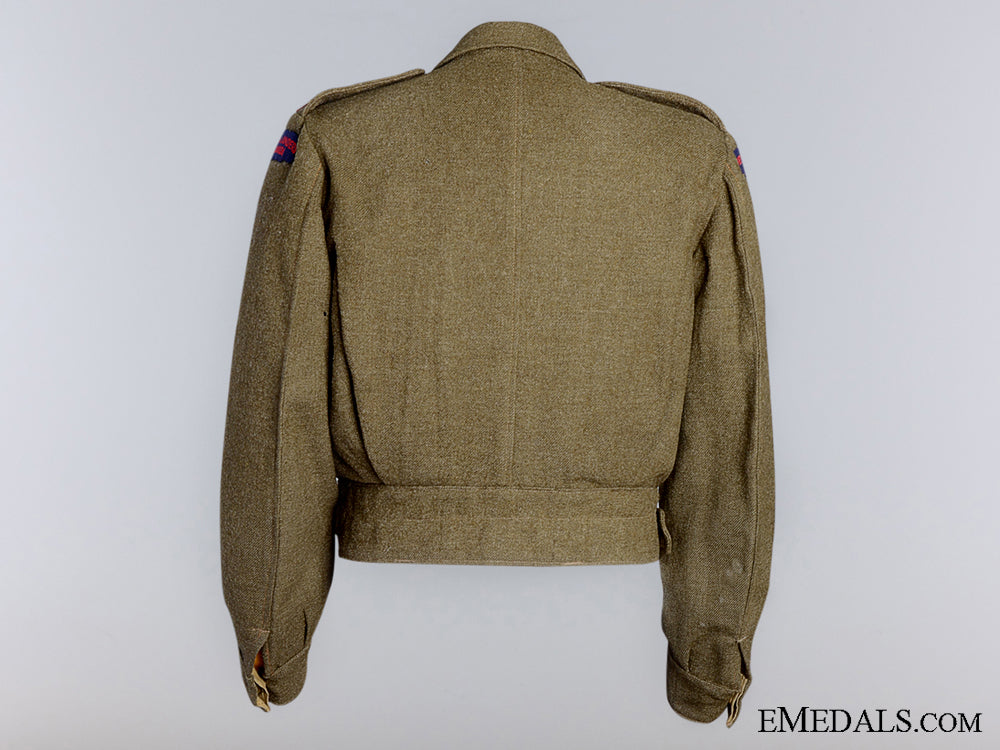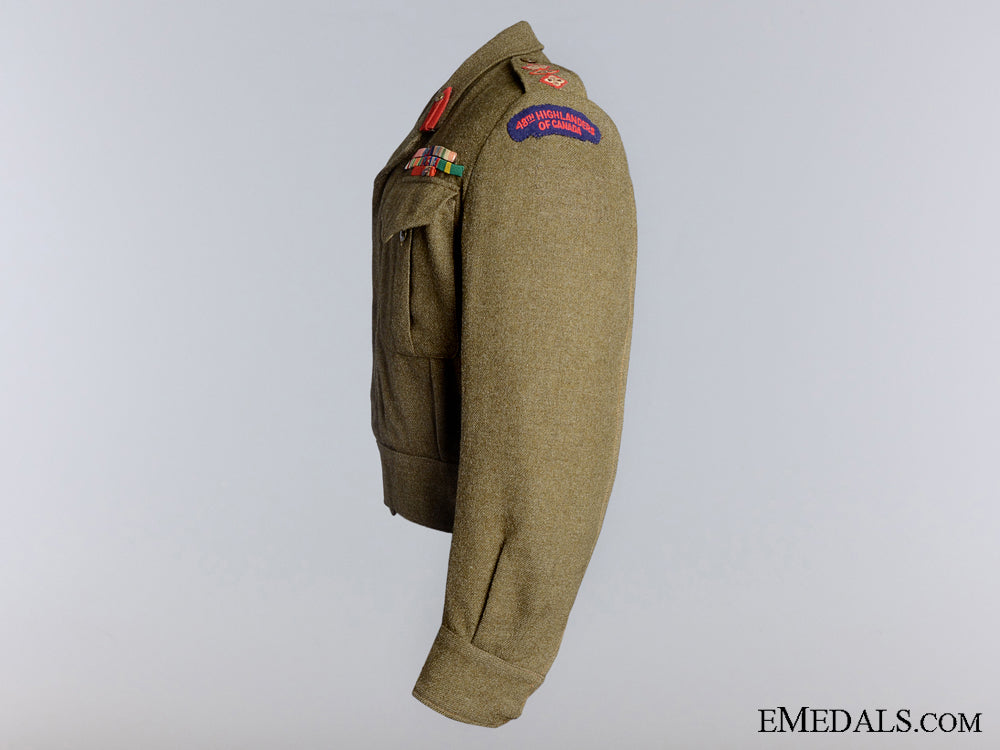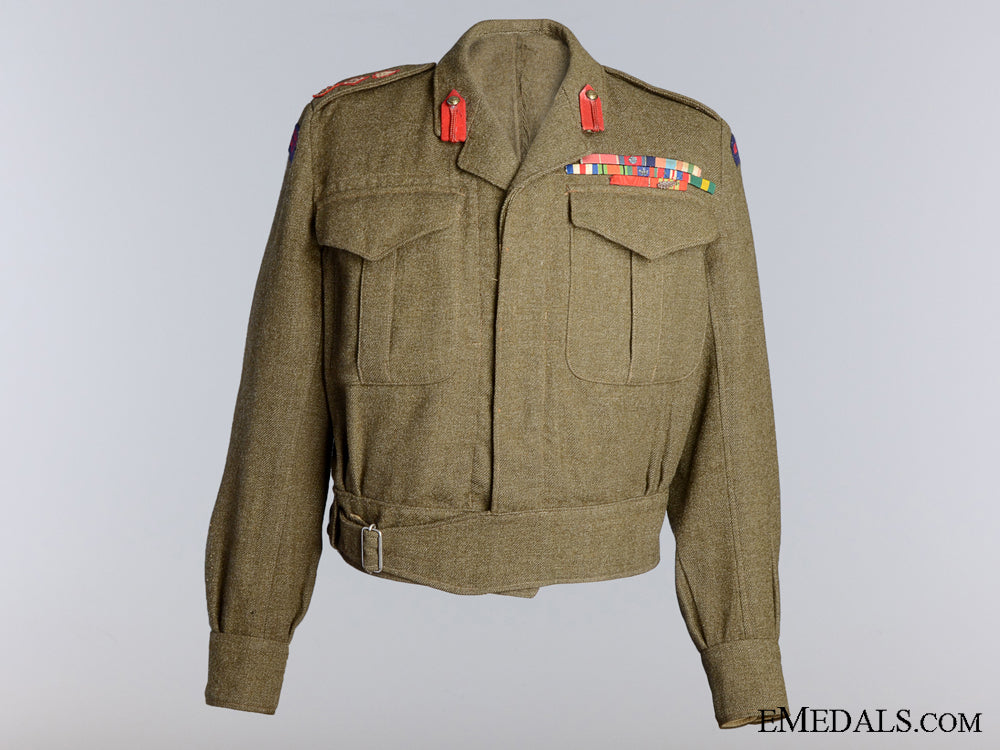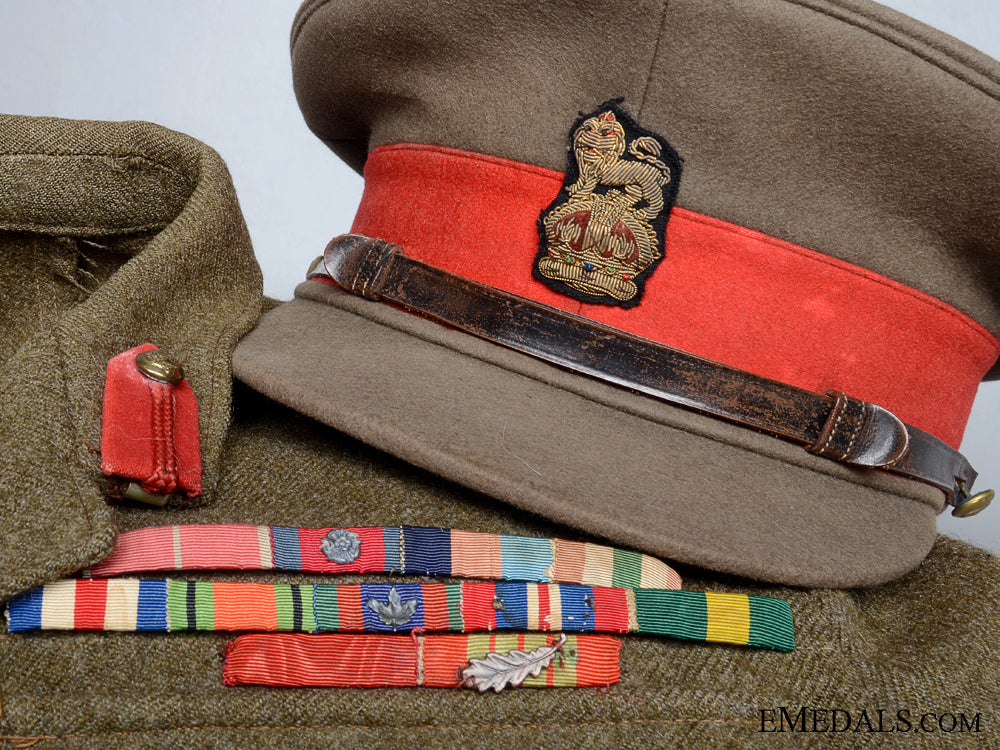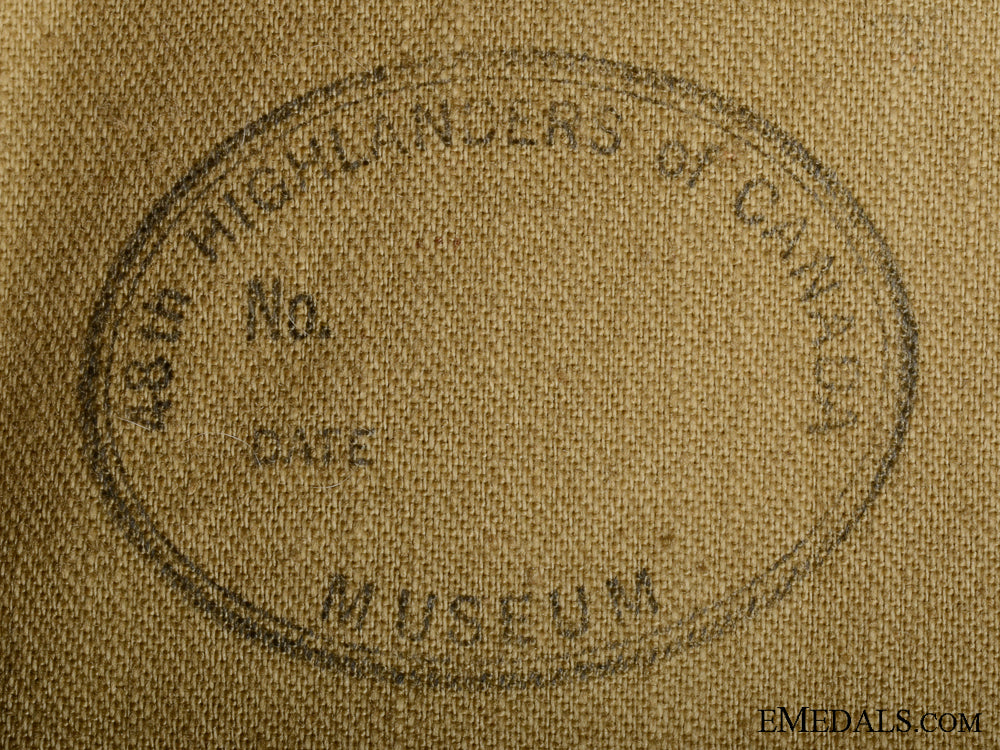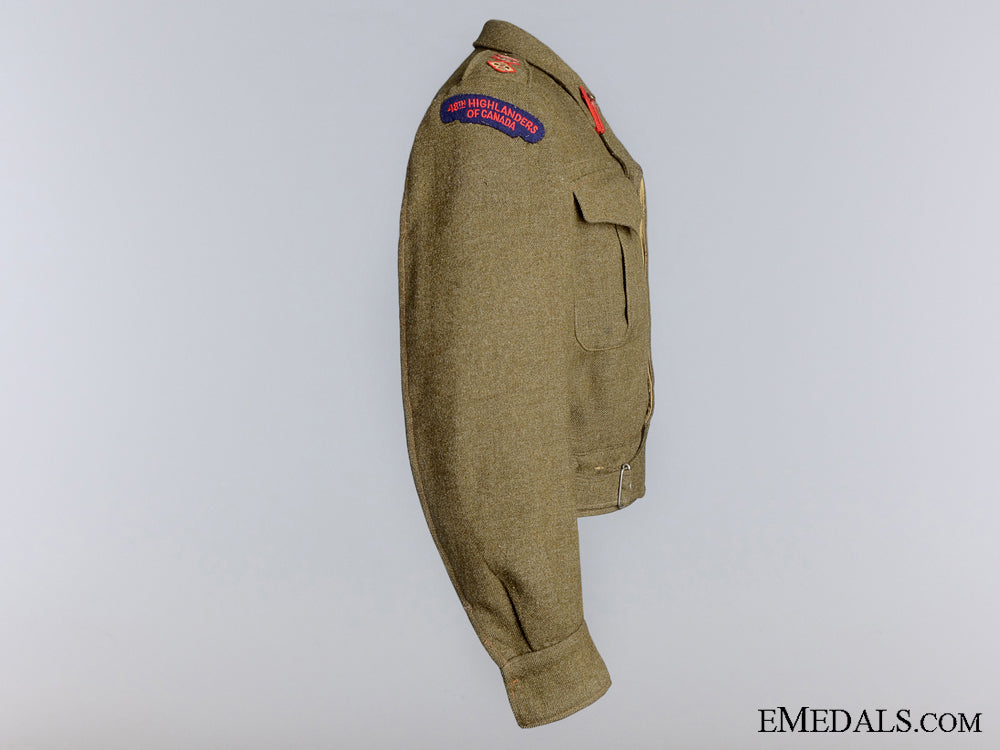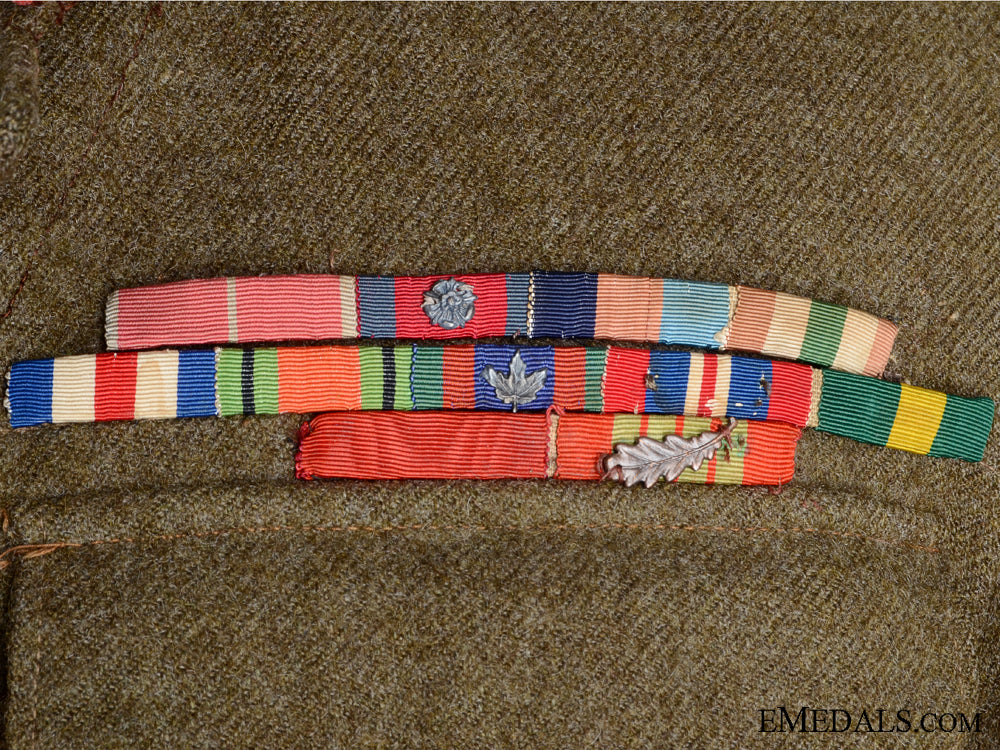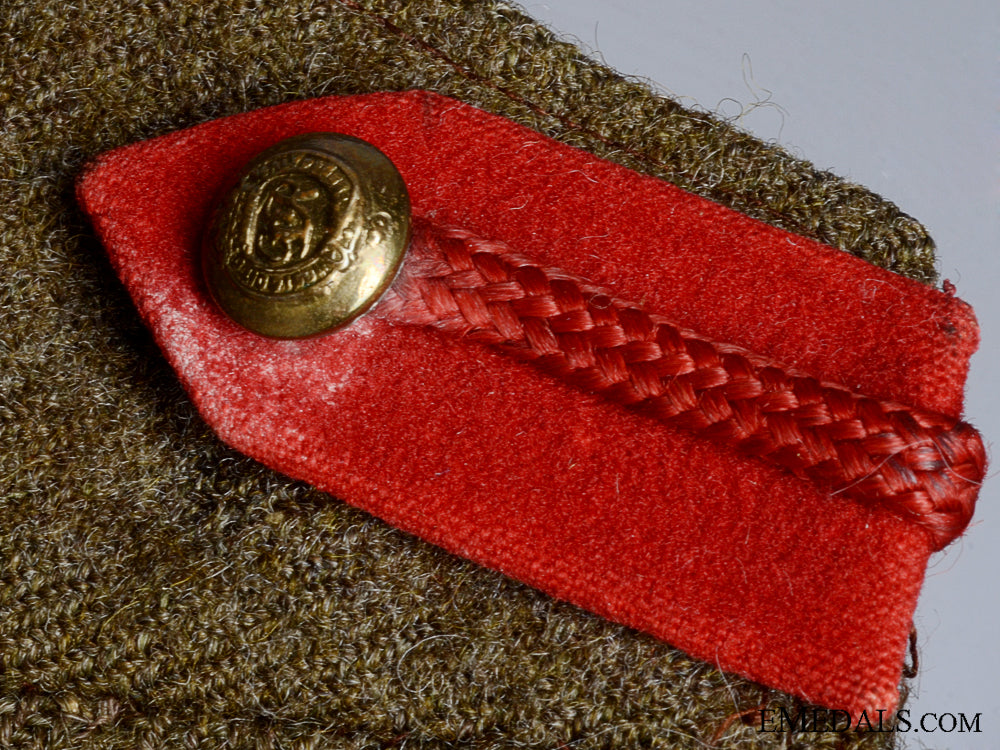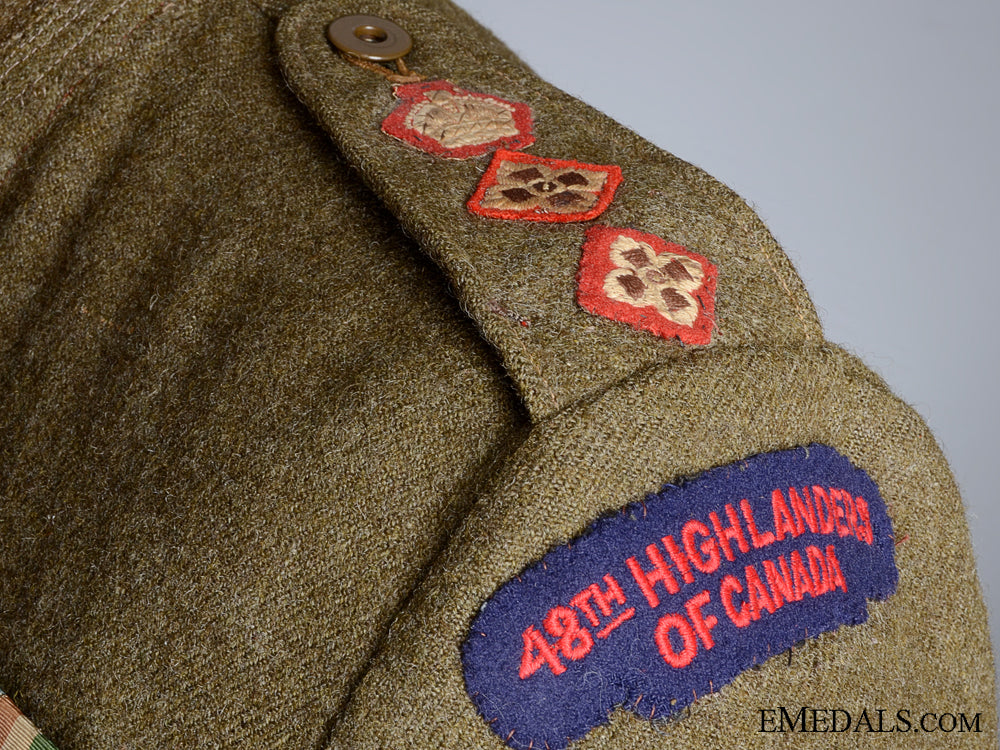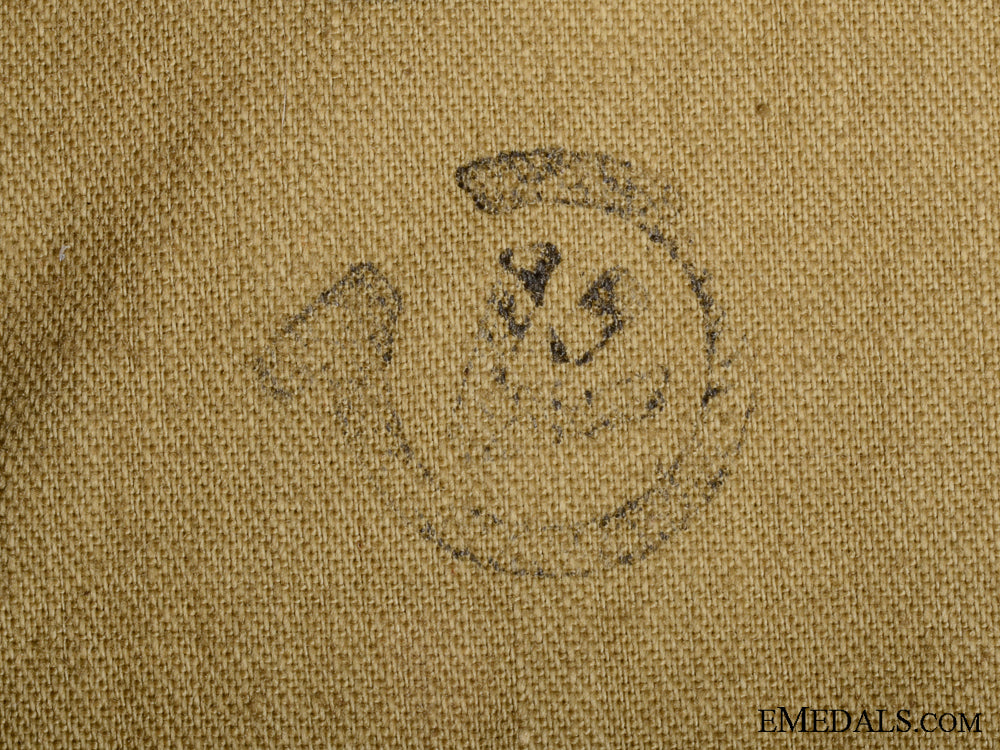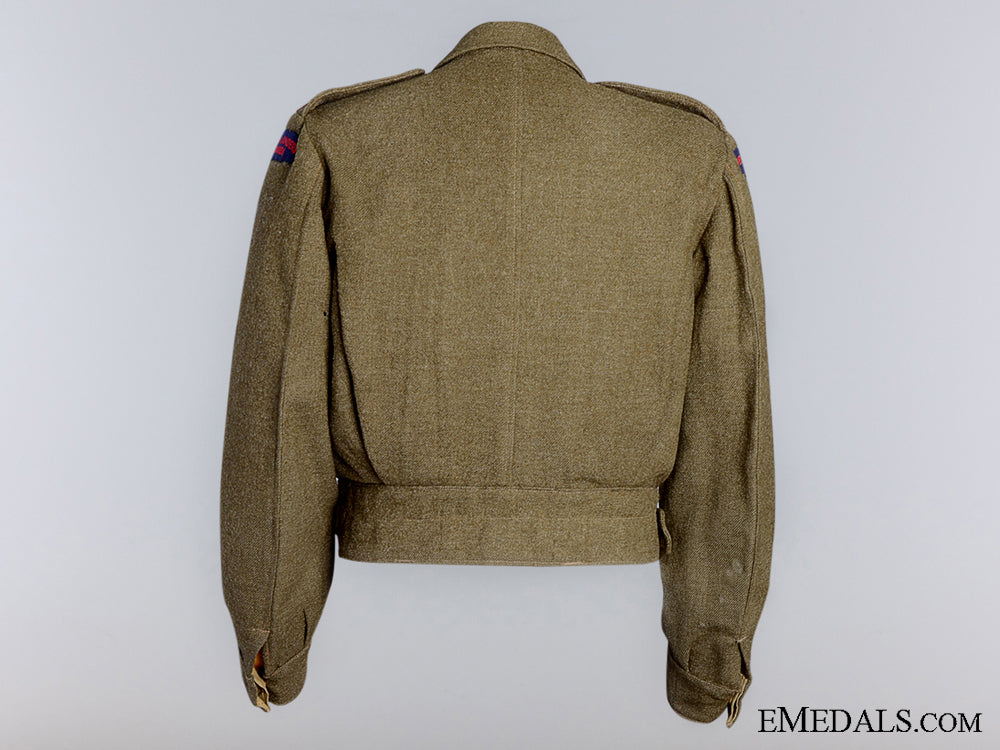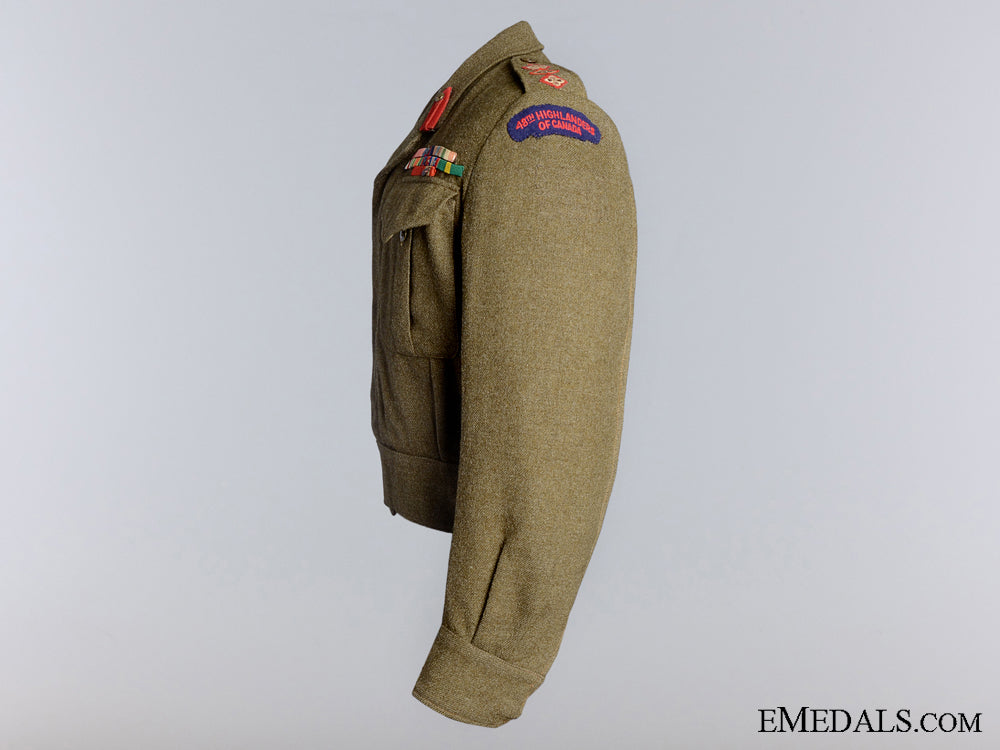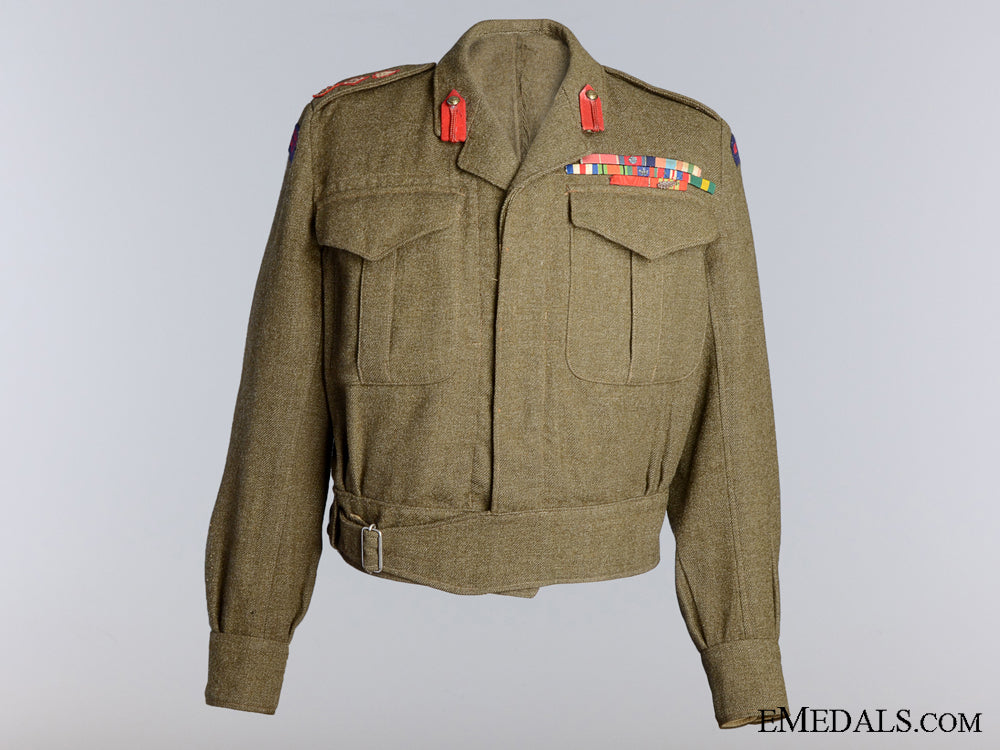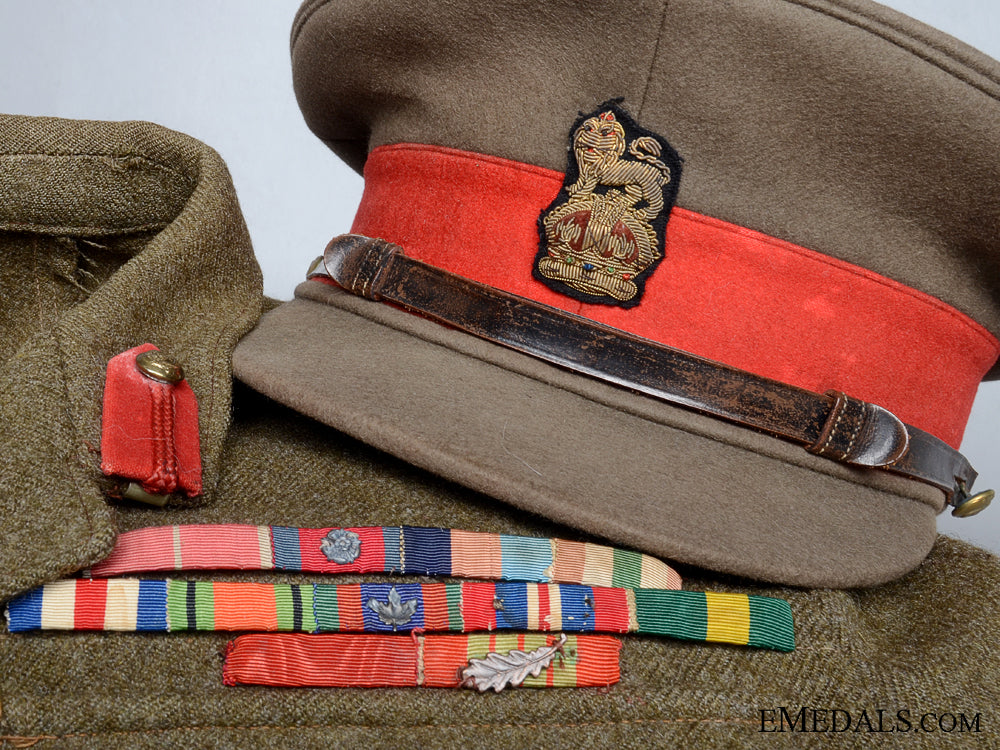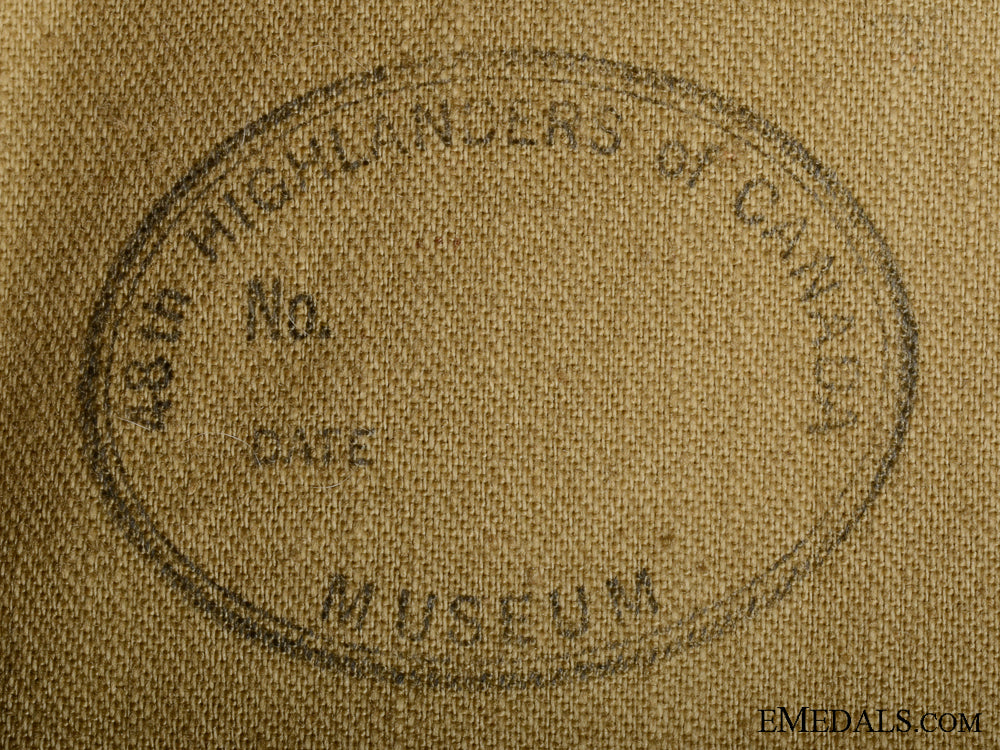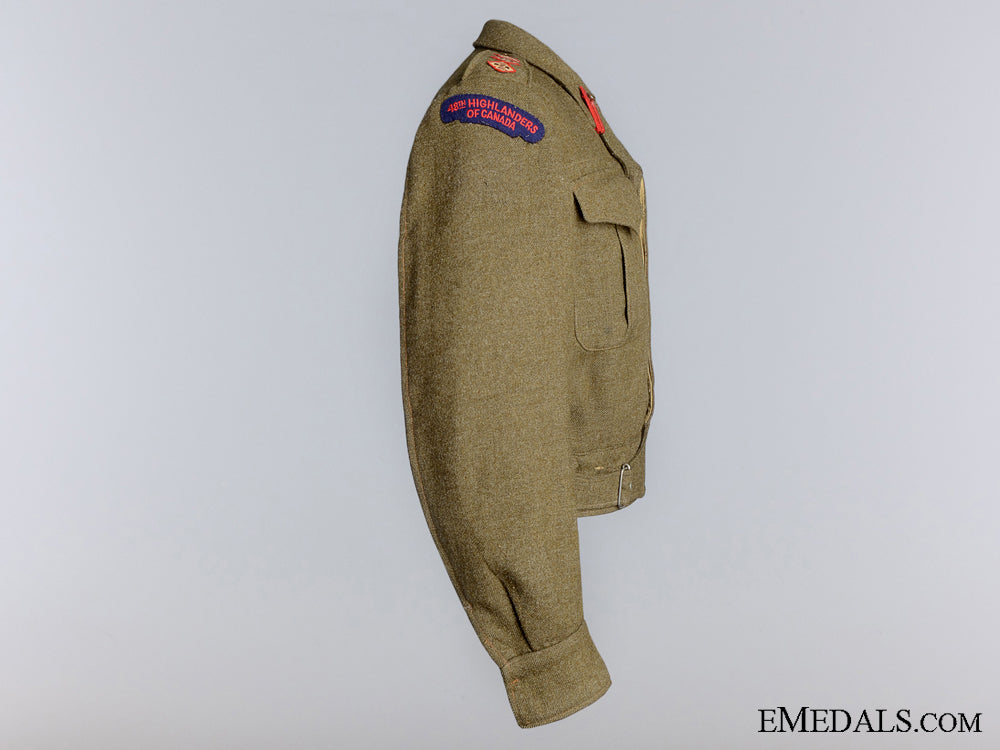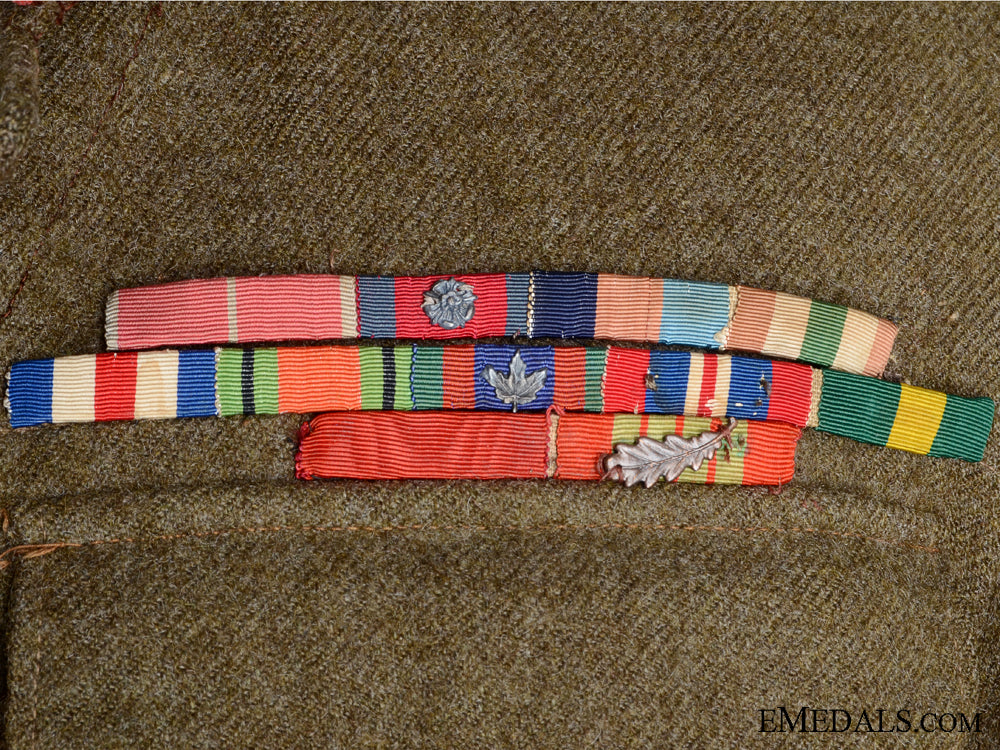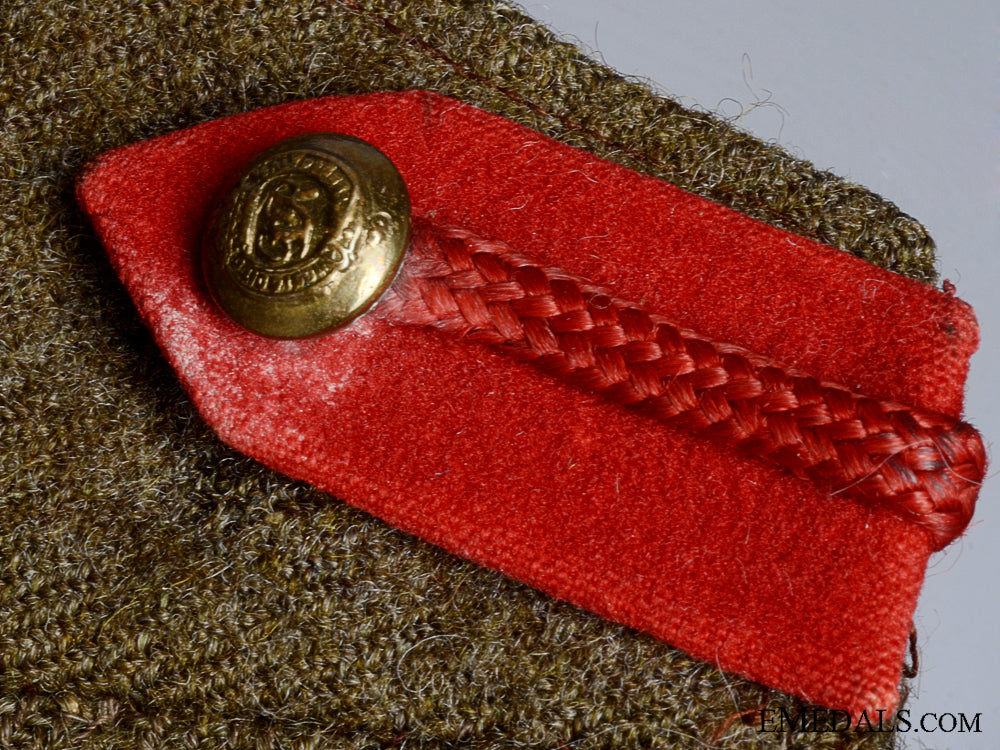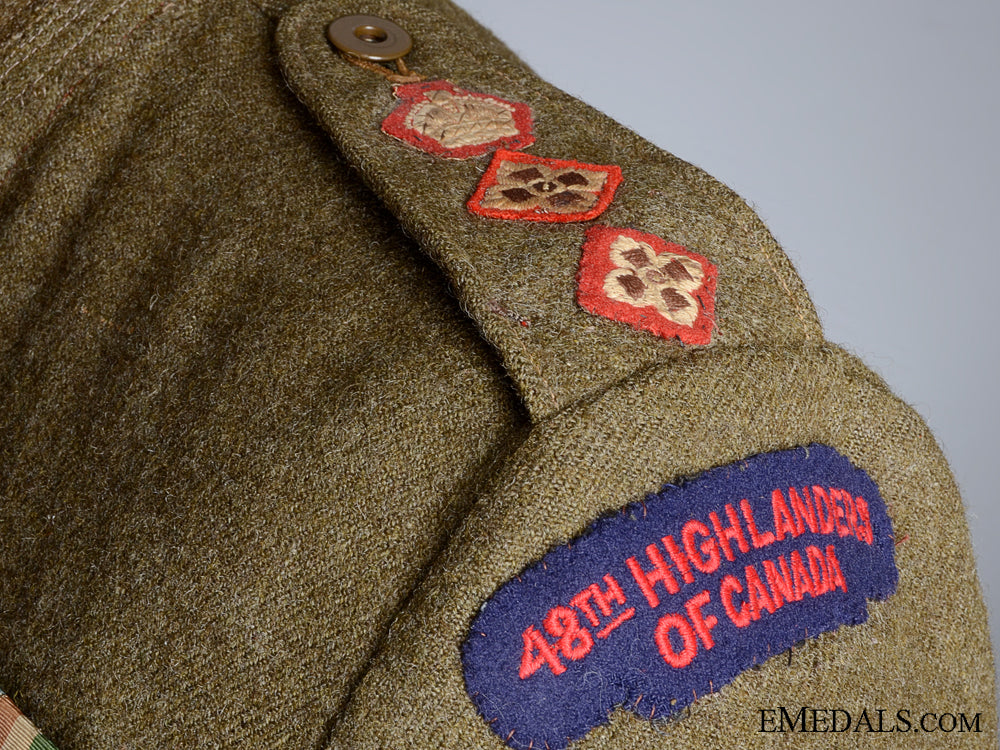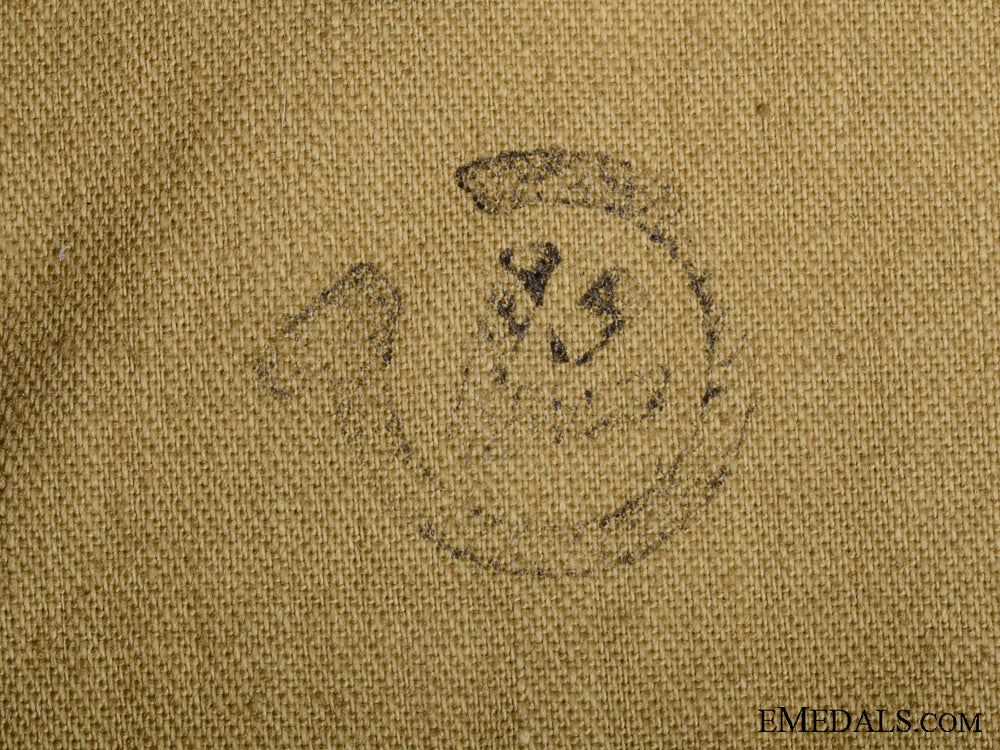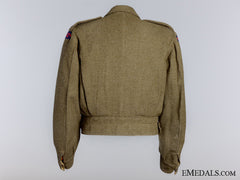Description
The WWII Battledress of the Commanding Officer of the 48th Highlanders, Ian Strachan Johnston, who was instrumental in the fighting in Ortona which resulted his first Distinguished Service Order. This battledress blouse is wool with a green tinge to the darker khaki colour, giving it that distinctive Canadian-look versus the British version, of which the Canadian one is patterned after. The blouse is adorned with 48th Highlanders of Canada shoulders flashes on both shoulders. The shoulders have button down epaulet straps held in place via metal buttons, each with one crown and two pips outlined in scarlet, the combination of the three insignias representative of the rank of Colonel. Each collar is adorned with a medium-sized red gorget patch with scarlet gimp and a brass GRVI General Service button, held in place via a hinged clip on the underside of the collar. The front has two pockets, one on each breast which have decorative straps giving them a pleated-look with metal buttons at the top. Each pocket has a foldover flap and when lifted up, exposes a reinforced button hole. When the buttons are fastened, they remain invisible to the eye, covered by the flaps. Above the left breast pocket are three rows of ribbon bars (first row: Commander of the Order of the British Empire (CBE), Distinguished Service Order with silver rosette, 1939-1945 Star and Italy Star; second row: France and Germany Star, Defence Medal, Canadian Volunteer Service Medal with overseas service Maple Leaf Clasp, War Medal 1939-1945 - missing its bronze MID Oak Leaf but the threading remains in place and GRVI Canadian Forces Efficiency Decoration; third row: France: Order of the Legion of Honour, Knight and France: Croix de Guerre. The front is completed by a vertical row of four metal buttons on the right side, facing an equal number of reinforced button holes on the left, similarly covered by a full-length flap, again remaining invisible to the eye. Along the waistline at the front is a strap on the left side, and when fed through the metal belt loop on the right side, ensures a snug fit at the waist. It comes with button down cuffs with metal buttons, and when fastened, again are invisible to the eye, plus three reinforced ventilation holes in each armpit. Inside, the waistline is reinforced with a 73 mm wide cotton band, with three reinforced button holes at the rear. The inside lapel on both sides has cotton-lined pockets, the right one stamped in black ink and displaying the maker stamp, "BATTLE DRESS BLOUSES, SERGE, Size No. 8, Height 5'7" to 5'8", Breast 37 - 38, S. & G. CLOTHING CO. LTD. 1944", with a Canadian Broad Arrow production mark and a Museum stamp inscribed "48th HIGHLANDERS of CANADA MUSEUM" above, the blouse itself measuring 440 mm across the shoulders and 540 mm in length overall. It exhibits one small hole below the shoulder flash on the right side, displaying a nice texture in the wool and quality workmanship, beautiful, intact stitching, very clean. Accompanied by his Colonel's service dress cap, the exterior fabricated from a chocolate brown wool, with a 46 mm wide band of red wool around the circumference, two brown leather straps with fixed loops creating the chin strap, of adjustable length resting upon the visor, slotted at the ends, secured on both sides by buttons with the Canada General Service insignia. Dowel reinforcing added to the top rim and wicker in a weave pattern creating the side walls, with the large flat visor incorporating a thick stiffener, the upper on the visor covered with the same chocolate wool as the exterior of the cap. The rear skirt of the cap comes with four ventilation eyelets. The front is adorned with a Colonel's insignia, illustrating the lion standing upon the crown, the insignia in gold bullion with touches of red threading in the lion's crown, eyes and mouth, touches of red, green and blue threading in the crown's base, along with maroon felt in the voided area of the crown. Inside, the cap has a 45 mm wide butterscotch-coloured leather sweatband, the two ends of the sweatband tied together at the rear via a white ribbon in a traditional bow-tie. The sides are lined in a ruby red nylon, the dome covered in a moisture-resistant fabric nylon cord, with the maker's label stamped in black ink but is indistinguishable, as it has faded with time, the cap measuring 265 mm x 290 mm x 120 mm overall. Although the leather sweatband exhibits wear from active use, the moisture-resistant nylon cord and peeled away in scattered locations in the dome and mothing is evident on the red wool band on the exterior, the cap continues to exhibit flawless, quality workmanship, maintaining its original period look. Together, extremely fine.
Footnote: Ian Strachan Johnston CBE DSO (2) ED KC was born in 1908 in Toronto, Ontario, the son of Strachan Johnston KC (King's Counsel) and May M. (Walker) Johnston both of Toronto. He was educated at Ridley College in St. Catharines, Ontario, with Brigadier Ian Strachan Johnston ’19 earning the highest military rank of any Old Boy in the school’s history, later graduating from Royal Military College in Kingston, Ontario. In the Royal Military College Yearbook for the Class of 1930, on page 183, his biography describes a young, energetic and successful officer: "CPL. IAN STRACHAN JOHNSTON. Ian was one of the members of the class or '29 that joined us in our recruit year, and since has stuck with us, With a year's experience ahead of us he was able to pass on 'manly a kindly word of advice as to how the well-mannered recruit behaves, and the transformation he wrought in turning eight plodding recruits in to a Follies chorus for our Cake Walk was phenomenal. Ian was born in Toronto and Ridley had the honour of guiding his faltering footsteps along the paths of learning. Ian has always been found on Platoon rugby teams, wears crossed whips and rifles on his arm, and became the capable manager of the hockey team this year. Ian has decided on law for his life work, and we're sure that the success he has attained here will follow him to Osgoode Hall." Johnston joined the 48th Highlanders of Canada in 1930 as a 2nd Lieutenant and in 1933, Johnston was called to the Bar of Ontario and began practicing law under the auspices of the Law Society of Upper Canada. Six years later, in September 1939, Johnston joined the 48th Highlanders of Toronto active army battalion, with the rank of Lieutenant. In December 1939, he went overseas and was promoted to Major, followed by an appointment to Commanding Officer of the 48th Highlanders in January 1943. In May 1943, he was promoted to Lieutenant-Colonel and landed in Pachino, Sicily with his troops in July 1943. The Moro River - Ortona battles in December 1943, are at the heart of a special relationship between the 48th Highlanders and The Royal Canadian Regiment. December 1943 proved to be the bloodiest and bitterest month of the war for the Battalions of the 1st Canadian Infantry Brigade. The Royal Canadian Regiment had landed in Sicily five months previously with 756 officers and men. By the end of December, less than 200 of these originals would still be with the unit. The crucible of the Moro River and Ortona battles would forever define the characters of The Royal Canadian Regiment and the 48th Highlanders and the relationship between the two Regiments. During the month of December, these Battalions fought heroically in several desperate, but ultimately victorious battles, including San Leonardo, the Gully, Ortona, and San Nicola – San Tommaso. The best remembered engagements of the war were those fought at Ortona Crossroads by The RCR and the capture of Cemetery Hill by the 48th Highlanders. Throughout this trying month, neither the 48th Highlanders nor The RCR were allowed to rest in reserve, but remained in constant contact with the enemy. By December 20th, the prolonged, bloody street fighting in the town of Ortona, involving the 2nd Canadian Infantry Brigade, had begun. On December 22nd, the 1st Canadian Infantry Brigade was ordered to drive northwards from the Ortona Crossroads, outflank the seaport to the west, and cut the coastal highway to the north of Ortona. It was on the night of December 23rd-24th that the 48th Highlanders, commanded by Lieutenant-Colonel Ian Strachan Johnston, performed one of the most remarkable feats of arms of the war. Much depleated by casualties, weakened by exhaustion, the Highlanders were asked to penetrate the German lines and capture a high, dominating plateau on Riccio Ridge facing the village of San Tommaso, just two miles west of Ortona. Furthermore, the objective had to be captured without prior artillery preparation or benefit of supporting arms. Carrying only personal weapons, the Battalion moved off into the night in single file, following a hidden footpath. Utilizing the elements of stealth and surprise, the 48th Highlanders were able to march a mile behind enemy lines and capture their objective without firing a shot. However, the Battalion was now isolated on prominent, vital ground in the midst of the German 1st Parachute Division. The Battalion dug in and was in all round defence by dawn. The situation was precarious in the extreme, with the unit cut off and out of communications with Brigade Headquarters. Enemy activity grew throughout the day and at dusk, the 48th Highlanders were facing their first serious counter-attack from the German paratroopers. The Battalion spent Christmas Day surrounded by an ever tightening ring of enemy firepower, with fire from German 88 MM guns, machine-guns, mortars, and snipers a constant menace. “A” Company launched a local attack to throw the Germans off balance. That Christmas Day on Cemetery Hill, the 48th Highlanders lost eight men killed and six wounded. That night a patrol from The RCR finally reached the lines of the 48th with news of a Brigade carrying party, bringing food, ammunition, radio batteries, and rum. The RCR, badly under strength, had been desperately trying to break through to the 48th Highlanders since first light on the morning of December 24th. Without artillery support, over ground that was a morass, and in the teeth of heavy German resistance, these efforts had been in vain. Very heavy casualties were suffered in the process. The RCR had renewed the attack on Christmas morning. Within minutes "A" Company, only 50 men strong to begin with, had lost 20 men killed and wounded. "B" Company was also hit hard. In just two days of fighting to rescue the 48th Highlanders, the RCR had lost over 50 men in action. After Christmas Day, the Regiment could muster less than 150 men. At 1000 hours onDecember 26th, the enemy threw everything it had at the 48th Highlanders in a co-ordinated and sustained attack. The fighting was intense, vicious, and often hand-to-hand. Victory hung in the balance when three tanks of the Ontario Regiment arrived from the rear. With the tanks in support, the 48th Highlanders now launched their own counter-attack, wreaking havoc on the Germans. An estimated 120 Germans were killed or captured. By December 27th, the 48th Highlanders were no longer isolated and the German 1st Parachute Division was falling back. With the capture, first, of the Ortona Crossroads by The RCR, then of Cemetery Hill by the 48th Highlanders, the German defenders at the seaport of Ortona were in danger of being trapped. On the night of December 27th-28th, these German paratroopers hastily abandoned Ortona." For his leadership and the textbook execution of the artillery-infantry-tank integration required for success for Operation Morning Glory at the Battle of Ortona, Johnston was awarded the Distinguished Service Order. Then came the Hitler Line, fortified by concrete, artillery, mortars, machine guns, anti-tank ditches, wire, Teller and box mines, and manned by 8,300 troops. The Germans claimed it was impregnable. In late May 1944, in fierce fighting and without tactical support, the 48th Highlanders became the first Canadian battalion to break the Germans’ strongest position in Italy. In recognition, Johnston was made Chevalier de la Legion d'Honneur (Order of the Legion of Honour, Knight) and awarded him the Croix de Guerre avec Palme (War Cross 1939-1945 with bronze Palm). In June 1944, he was promoted to Brigadier and placed in command of the 11th Canadian Infantry Brigade. In February 1945, he proceeded to France and the North-West Europe campaign, where Johnston and his brigade led a major attack on German forces in Holland and in June 1945, he was promoted to General Officer Commanding, 5th Canadian Armoured Division, a post he held until the division was dissolved that December. A newspaper of the day wrote, “The men who served under him always speak of him as one of the most popular officers in the Canadian army”. He retired from active service as one of the most decorated Canadians of the war: Johnston was twice awarded the Distinguished Service Order (DSO) for conspicuous gallantry on two occasions, as published in the Supplement to the London Gazette 36426 of Tuesday, March 14, 1944, on Thursday, March 16, 1944, page 1263 (Ian Strachan Johnston, Canadian Infantry Corps). In addition, the British government named Johnston a Commander of the Order of the British Empire (CBE), as published in the London Gazette on October 11, 1945. He was awarded the Canadian Forces Efficiency Decoration (ED) for his service with the 48th Highlanders. In addition, the French government named Johnston, a Chevalier de la Legion d'Honneur (Order of the Legion of Honour, Knight) and awarded him the Croix de Guerre avec Palme (War Cross 1939-1945 with bronze Palm). In addition, for his Second World War service, he was awarded the 1939-1945 Star, the Italy Star, the France and Germany Star, the Defence Medal, the Canadian Volunteer Service Medal with Overseas Clasp and the War Medal 1939-1945 with MID Oak Leaf. In January 1946, Johnston returned to Canada and was transferred to the 4th Canadian Infantry Brigade of the Reserve Army. He returned to the legal profession, practicing law as a partner in the firm Johnston, Heighington & Johnst
n in Toronto. He was also a Director of Maple Leaf Gardens, a Commissioner of a 1964 study which led to a major reorganization of Canada’s militia, and Honourary 1Colonel of the 48th Highlanders. In February 1947, he married Deborah E. Armstrong, daughter of Mr. and Mrs. John L. Coulson and they had one son, Strachan Johnston. Ian Strachan Johnston died in 1984, at the age of 76.

